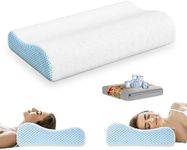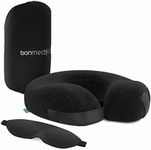Buying Guide for the Best Apnea Pillows
Choosing the right apnea pillow can significantly improve your sleep quality and help manage sleep apnea symptoms. These pillows are designed to support your head and neck in a way that keeps your airways open, reducing the likelihood of breathing interruptions during sleep. When selecting an apnea pillow, consider your sleeping position, personal comfort preferences, and any specific features that might enhance your sleep experience. Understanding the key specifications will help you make an informed decision that aligns with your needs.MaterialThe material of an apnea pillow affects its comfort, support, and durability. Common materials include memory foam, latex, and polyester fiberfill. Memory foam is popular for its contouring ability, providing personalized support by molding to the shape of your head and neck. Latex offers a firmer feel and is often more breathable, which can be beneficial if you tend to sleep hot. Polyester fiberfill is usually softer and more affordable but may not offer the same level of support. Consider your comfort preferences and any allergies when choosing the material.
Shape and DesignThe shape and design of an apnea pillow are crucial for ensuring proper alignment and support. Contoured pillows are designed to cradle the head and neck, promoting an open airway. Some pillows have cutouts or raised edges to accommodate CPAP masks, which can be beneficial if you use one. Wedge-shaped pillows elevate the upper body, which can help reduce snoring and improve breathing. Choose a shape that complements your sleeping position and any additional needs, such as CPAP mask compatibility.
FirmnessFirmness determines how much support the pillow provides and how comfortable it feels. A firmer pillow can offer better support for keeping the airways open, but it might not be as comfortable for everyone. Softer pillows may feel more comfortable but might not provide the necessary support for some users. Consider your personal comfort preference and whether you need more support or a softer feel. If you're unsure, look for pillows with adjustable firmness options.
SizeThe size of an apnea pillow can affect both comfort and effectiveness. Standard, queen, and king sizes are common, but some apnea pillows come in unique dimensions to better suit their specialized design. A larger pillow may offer more room to move, while a smaller one might be easier to position correctly. Consider the size of your bed and your personal preference for pillow size when making your choice.
BreathabilityBreathability refers to how well the pillow allows air to circulate, which can affect temperature regulation during sleep. A breathable pillow can help prevent overheating, which is important for maintaining comfort throughout the night. Look for pillows with ventilated designs or materials known for their breathability, such as latex or gel-infused memory foam. If you tend to sleep hot, prioritizing breathability can enhance your sleep quality.
Hypoallergenic PropertiesHypoallergenic properties are important if you have allergies or sensitivities. Hypoallergenic pillows are made from materials that resist dust mites, mold, and other allergens, helping to create a healthier sleep environment. If you suffer from allergies, look for pillows labeled as hypoallergenic and consider those with removable, washable covers to maintain cleanliness and reduce allergen exposure.

















